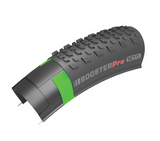KENDA - 29" BOOSTER PRO
The Booster is a World Cup proven XC race tyre that is aggressive enough to push traction to new limits. On top of that, it is also one of the fastest and lightest XC tyres on the market. You no longer want to choose between a XC tyre that is either fast and light, or provides great traction? The Booster combines the best of both worlds.
- New tread design - Modern and aggressive look, optimized for fast rolling and best in class cornering traction.
- New race compound - The Booster utilizes a newly developed race compound that is fast and grippy, especially on dry, loose over hard and rough and rocky terrain.
- Tubeless ready
| SIZE | COMPOUND | PROTECTION | BEAD | TPI | WEIGHT (G) |
|---|---|---|---|---|---|
| 29 x 2.20 (56-622) | SINGLE | SCT | FOLDING | 120 | 670±34 |
| 29 x 2.40 (61-622) | SINGLE | SCT | FOLDING | 120 | 690±35 |
SINGLE TREAD COMPOUND
Kenda's single tread compound construction uses the same compound over the whole tread of the tyre. This construction is found in many road, gravel, commuting and some mountain bike tyres. The characteristics of the compound itself vary between each category - a commuter tyre's compound will be more durable than a mountain bike compound - or even within the category as Kenda adapts the compound to each tyre. A mountain bike tyre that is intended to perform well in wet conditions will have a different compound than a tyre that is meant to excel in dry conditions. That way you can also be sure to get a tyre with a compound that was fine-tuned for that particular tyre.
SIDEWALL CASING TECHNOLOGY (SCT) - TUBELESS AND TOUGH
Kenda Sidewall Casing Technology (SCT) is the modification of existing Kenda tyre construction methods. By adding an additional sheet of Nylon fabric across the sidewall of the tyre, from bead up to tread block, it results in the optimization of the tyre construction for fluid based tubeless conversion systems. Additionally, the SCT construction increases the structural strength of sidewalls; bolstering resistance to slices and abrasions, helping reduce the chance of catastrophic damage that fluid sealants cannot seal.




